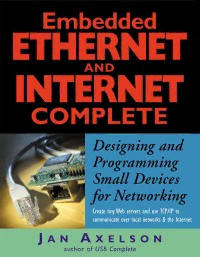
Embedded Ethernet and Internet Complete PDF
Preview Embedded Ethernet and Internet Complete
Cover Page: 1 Title Page Page: 2 Copyright Page: 3 Contents Page: 4 Introduction Page: 5 1. Networking Basics Page: 7 Quick Start: The Elements of a Network Page: 7 Components Page: 7 Modular Design Page: 7 The Network Protocol Stack Page: 8 Clients and Servers Page: 10 Requirements for Internet Communications Page: 10 A Word about Web Servers Page: 10 In Depth: Inside Ethernet Page: 10 Advantages Page: 11 Limits Page: 11 Using a PC for Network Communications Page: 12 The IEEE 802.3 Standard Page: 12 Frames Page: 13 Media Access Control: Deciding When to Transmit Page: 14 Physical Addresses Page: 16 Using a Protocol Analyzer to View Ethernet Traffic Page: 17 2. Building a Network: Hardware Options Page: 18 Quick Start: Connecting to a PC 36 Page: 18 Components and Configurations Page: 18 Other Options Page: 19 In Depth: Cables, Connections and Network Speed Page: 19 Cable Types for Different Uses Page: 19 Twisted Pair Cable Page: 20 Fiber Optic Cable Page: 22 Coaxial Cable Page: 24 Connections for Harsh Environments Page: 24 Supplying Power Page: 25 Going Wireless Page: 25 Media Systems Page: 25 Interfacing to Ethernet Controllers Page: 28 Using Repeater Hubs, Ethernet Switches, and Routers Page: 28 3. Design Choices Page: 32 Quick Start: Selecting Components Page: 32 Complete Solutions Page: 32 Special-Purpose Modules Page: 37 In Depth: Ethernet Controllers Page: 39 What the Hardware Does Page: 39 Ethernet Controller Basics Page: 39 The ASIX AX88796 Page: 40 Realtek RTL8019AS Page: 42 SMSC LAN91C96 Page: 42 Cirrus Logic CS8900A Page: 43 4. Using the Internet Protocol in Local and Internet Communications Page: 44 Quick Start: Connecting to the Internet Page: 44 Considerations in Obtaining Internet Service Page: 44 Technologies for Connecting Page: 45 Static and Dynamic IP Addresses Page: 46 Connecting Multiple Computers to the Internet Page: 46 Communicating through a Firewall Page: 47 Obtaining and Using a Domain Name Page: 47 In Depth: Inside the Internet Protocol Page: 49 What IP Does Page: 50 Ip Addresses Page: 50 The IP Header Page: 53 Assigning an IP Address to a Host Page: 54 Matching an IP Address to an Ethernet Interface Page: 55 How a Datagram Finds Its Way to Its Destination Page: 56 The Internet Control Message Protocol (Icmp) Page: 57 5. Exchanging Messages Using UDP and TCP Page: 58 Quick Start: Basic Communications Page: 58 Configuring a Device for Network Communications Page: 58 Sending UDP Datagrams Page: 60 Receiving UDP Datagrams Page: 62 Exchanging Messages Using TCP Page: 63 UDP and TCP From PC Applications Page: 65 In Depth: Inside UDP and TCP Page: 66 About Sockets and Ports Page: 66 UDP: Just the Basics Page: 67 TCP: Adding Handshaking and Flow Control Page: 68 6. Serving Web Pages with Dynamic Data Page: 73 Quick Start: Two Approaches Page: 73 Serving a Page with Dynamic Data Page: 73 Rabbit Realtime Web Page Page: 74 TINI Realtime Web Page Page: 75 In Depth: Protocols for Serving Web Pages Page: 77 Using the Hypertext Transfer Protocol Page: 77 HTTP Versions Page: 78 Elements of an HTTP Message Page: 78 Inside the Hypertext Markup Language Page: 80 Server Side Include Directives Page: 81 7. Serving Web Pages That Respond to User Input Page: 83 Quick Start: Device Controller Page: 83 The Device Controller’s Web Page Page: 83 Rabbit Device Controller Page: 83 TINI Device Controller Page: 85 In Depth: Using Cgi and Servlets Page: 88 Cgi for Embedded Systems Page: 88 Servlets for Embedded Systems Page: 89 Receiving Form Data Page: 90 8. E-Mail for Embedded Systems 339 Page: 95 Quick Start: Sending and Receiving Messages Page: 95 Sending an E-Mail From a Rabbit Page: 95 Sending an E-Mail From a TINI Page: 96 Receiving E-Mail on a Rabbit Page: 97 Receiving E-Mail on a TINI Page: 97 In Depth: E-Mail Protocols Page: 98 How E-Mail Works Page: 98 Using the Simple Mail Transfer Protocol Page: 99 Sending E-Mail with a Url Page: 102 Using the Post Office Protocol Page: 102 9. Using the File Transfer Protocol Page: 105 Quick Start: FTP Clients and Servers Page: 105 Rabbit FTP Client Page: 105 TINI FTP Client Page: 106 Rabbit FTP Server Page: 108 TINI FTP Server Page: 109 In Depth: Inside the File Transfer Protocol Page: 109 Requirements Page: 110 Transferring a File Page: 110 Commands Page: 111 Requesting a File with a Url Page: 113 10. Keeping Your Devices and Network Secure Page: 114 Quick Start: Limiting Access with Passwords Page: 114 Using Basic Authentication Page: 114 Basic Authentication on the Rabbit Page: 115 Basic Authentication on the TINI Page: 115 In Depth: Four Rules for Securing Your Devices and Local Network Page: 116 Use a Firewall Page: 116 Restrict Access with User Names and Passwords Page: 117 Validate User Data Page: 118 Encrypt Private Data Page: 118 Index Page: 120
Description: